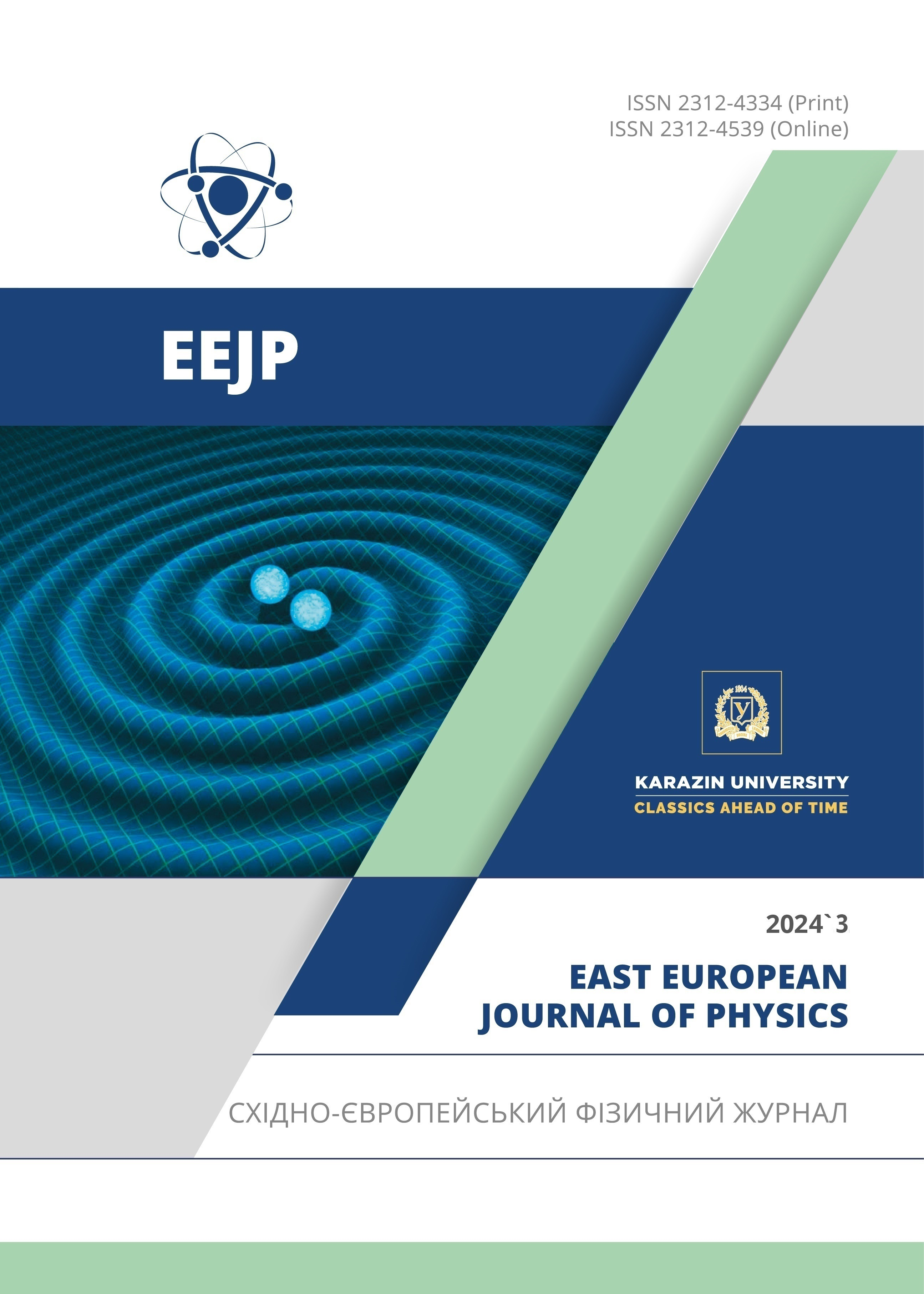Обмежувальна логарифмıчна модель f(R,T) ıз використанням параметра щıльностı темної енергıї ΩΛ і параметра Хаббла H0
Анотація
З багатьох розширених теорiй гравiтацiї гравiтацiя f(R, T) останнiм часом викликала розумний iнтерес, оскiльки вона дає цiкавi результати в космологiї. Логарифмiчнi поправки в модифiкованих теорiях гравiтацiї були широко вивченi. У цiй роботi ми розглянули логарифмiчну поправку до члена слiду T i прийняли функцiональну форму як f(R, T) = R+16πGαlnT, де α є вiльним параметром. Вiльний параметр обмежується за допомогою параметра щiльностi темної енергiї ΩΛ i параметра Хаббла H0. Нижня межа становить α ≥ −9,85×10−29. Також вивчаються космологiчнi наслiдки.
Завантаження
Посилання
A.G. Riess, A.V. Filippenko, P. Challis, A. Clocchiatti, A. Diercks, P.M. Garnavich, R.L. Gilliland, et al., ”Observational evidence from supernovae for an accelerating universe and a cosmological constant,” The Astronomical Journal, 116, 1009 (1998). https://doi.org/10.1086/300499
S. Perlmutter, G. Aldering, G. Goldhaber, R. Knop, P. Nugent, P.G. Castro, S. Deustua, et al., ”Measurements of Ω and Λ from 42 high-redshift supernovae,” The Astrophysical Journal, 517, 565 (1999). https://doi.org/10.1086/307221
E.J. Copeland, M. Sami, and S. Tsujikawa, ”Dynamics of dark energy,” International Journal of Modern Physics D, 15, 1753 (2006). https://doi.org/10.1142/S021827180600942X
N. Aghanim, Y. Akrami, M. Ashdown, J. Aumont, C. Baccigalupi, M. Ballardini, A. Banday, et al., ”Planck 2018 results-vi. cosmological parameters,” Astronomy and Astrophysics 641, A6 (2020). https://doi.org/10.1051/0004-6361/201833910
S. Weinberg, ”The cosmological constant problem,” Reviews of modern physics, 61, 1 (1989). https://doi.org/10.1103/RevModPhys.61.1
A.A. Starobinsky, ”Dynamics of phase transition in the new inflationary universe scenario and generation of perturbations,” Physics Letters B, 117, 175-178 (1982). https://doi.org/10.1016/0370-2693(82)90541-X
S. Nojiri, and S.D. Odintsov, ”Modified gauss–bonnet theory as gravitational alternative for dark energy,” Physics Letters B, 631, 1-6 (2005). https://doi.org/10.1016/j.physletb.2005.10.010
S. Nojiri, and S.D. Odintsov, ”Modified gravity and its reconstruction from the universe expansion history,” Journal of Physics: Conference Series, 66, 012005 (2007). https://doi.org/10.1088/1742-6596/66/1/012005
M. Sharif, and A. Ikram, ”Energy conditions in f(G,T) gravity,” The European Physical Journal C, 76, 640 (2016). https://doi.org/10.1140/epjc/s10052-016-4502-1
T. Harko, F.S. Lobo, S. Nojiri, and S.D. Odintsov, ”f(R,T) gravity,” Physical Review D, 84, 024020 (2011). https://doi.org/10.1103/PhysRevD.84.024020
J.B. Jim´enez, L. Heisenberg, and T. Koivisto, ”Coincident general relativity,” Physical Review D, 98, 044048 (2018). https://doi.org/10.1103/PhysRevD.98.044048
Y. Xu, G. Li, T. Harko, and S.-D. Liang, ”f (q,t) gravity,” The European Physical Journal C, 79, 708 (2019). https://doi.org/10.1140/epjc/s10052-019-7207-4
S. Nojiri, S. Odintsov, and V. Oikonomou, ”Modified gravity theories on a nutshell: inflation, bounce and late-time evolution,” Physics Reports, 692, 1-104 (2017). https://doi.org/10.1016/j.physrep.2017.06.001
S. Bhattacharjee, J. Santos, P. Moraes, and P. Sahoo, ”Inflation in f(R,T) gravity,” The European Physical Journal Plus, 135, 576 (2020). https://doi.org/10.1140/epjp/s13360-020-00583-6
M. Gamonal, ”Slow-roll inflation in f(R,T) gravity and a modified Starobinsky-like inflationary model,” Physics of the Dark Universe, 31, 100768 (2021). https://doi.org/10.1016/j.dark.2020.100768
B. Deb, and A. Deshamukhya, ”Inflation in f(R,T) gravity with double-well potential,” International Journal of Modern Physics A, 37, 2250127 (2022). https://doi.org/10.1142/S0217751X22501275
C.-Y. Chen, Y. Reyimuaji, and X. Zhang, ”Slow-roll inflation in f(R,T) gravity with a RT mixing term,” Physics of the Dark Universe, 38, 101130 (2022). https://doi.org/10.1016/j.dark.2022.101130
S. Bhattacharjee, and P. Sahoo, ”Constraining f(R,T) gravity from the dark energy density parameter ΩΛ,” Gravitation and Cosmology, 26, 281-284 (2020). https://doi.org/10.1134/S0202289320030032
M. Houndjo, and O.F. Piattella, ”Reconstructing f(R,T) gravity from holographic dark energy,” International Journal of Modern Physics D, 21, 1250024 (2012). https://doi.org/10.1142/S0218271812500241
A. Pasqua, S. Chattopadhyay, and I. Khomenko, ”A reconstruction of modified holographic ricci dark energy in f(R,T) gravity, Canadian Journal of Physics, 91, 632 (2013). https://doi.org/10.1139/cjp-2013-0016
J. Singh, and N. Sharma, ”Bianchi type-ii dark energy model in f(R,T) gravity, International Journal of Theoretical Physics, 53, 1424-1433 (2014). https://doi.org/10.1007/s10773-013-1939-y
D. Reddy, R.S. Kumar, and T.P. Kumar, ”Bianchi type-III dark energy model in f(R,T) gravity,” International Journal of Theoretical Physics, 52, 239-245 (2013). https://doi.org/10.1007/s10773-012-1325-1
R. Zaregonbadi, M. Farhoudi, and N. Riazi, ”Dark matter from f(R,T) gravity, Physical Review D, 94, 084052 (2016). https://doi.org/10.1103/PhysRevD.94.084052
N. Godani, and G.C. Samanta, ”Wormhole modeling in f(R,T)gravity with minimally-coupled massless scalar field,” International Journal of Modern Physics A, 35, 2050186 (2020). https://doi.org/10.1142/S0217751X20501869
A.K.M. Shweta, and U.K. Sharma, ”Traversable wormhole modelling with exponential and hyperbolic shape functions in I framework,” International Journal of Modern Physics A, 35(25), 2050149 (2020). https://doi.org/10.1142/S0217751X20501493
Авторське право (c) 2024 Бiсваджит Деб, Атрi Дешамукх’я

Цю роботу ліцензовано за Міжнародня ліцензія Creative Commons Attribution 4.0.
Автори, які публікуються у цьому журналі, погоджуються з наступними умовами:
- Автори залишають за собою право на авторство своєї роботи та передають журналу право першої публікації цієї роботи на умовах ліцензії Creative Commons Attribution License, котра дозволяє іншим особам вільно розповсюджувати опубліковану роботу з обов'язковим посиланням на авторів оригінальної роботи та першу публікацію роботи у цьому журналі.
- Автори мають право укладати самостійні додаткові угоди щодо неексклюзивного розповсюдження роботи у тому вигляді, в якому вона була опублікована цим журналом (наприклад, розміщувати роботу в електронному сховищі установи або публікувати у складі монографії), за умови збереження посилання на першу публікацію роботи у цьому журналі.
- Політика журналу дозволяє і заохочує розміщення авторами в мережі Інтернет (наприклад, у сховищах установ або на особистих веб-сайтах) рукопису роботи, як до подання цього рукопису до редакції, так і під час його редакційного опрацювання, оскільки це сприяє виникненню продуктивної наукової дискусії та позитивно позначається на оперативності та динаміці цитування опублікованої роботи (див. The Effect of Open Access).








